Sharpening the Sentinel-2 10 and 20 m Bands to Planetscope-0 3 m Resolution
Abstract
:1. Introduction
2. Data and Study Sites
2.1. Satellite Data Characteristics
2.2. Study Sites and Satellite Data
2.3. Data Preprocessing
3. Sharpening Methods
3.1. Overview and Core Processing Calculations
3.1.1. Planetscope-0 Spatial Degradation
3.1.2. Planetscope-0 synthetic Red-edge and SWIR Band Derivation
3.2. High Pass Modulation (HPM) Sharpening
3.3. Model-3 (M3) Sharpening
3.4. Sharpening Evaluation
4. Results
4.1. Visual Evaluation
4.2. Visual Evaluation of Spatial Subsets Containing Surface Change
4.3. Quantitative Evaluation
4.3.1. Quantitative Study Site Evaluation
4.3.2. Quantitative Evaluation for the Spatial Subsets Containing Surface Change
5. Discussion
6. Conclusions
- (1)
- the HPM and M3 approaches introduced less spatial and spectral distortion in the sharpened Sentinel-2 visible, red-edge, NIR, and SWIR 10 m and 20 m bands relative to conventional Sentinel-2 bilinear resampling; and, over surfaces with no change between the Sentinel-2 and Planetscope-0 acquisitions, the two sharpening methods produced similar results;
- (2)
- the HPM and M3 sharpened Sentinel-2 20 m red-edge and SWIR bands were visually coherent but had more spatial and spectral distortion ( values > 0.76) than the sharpened Sentinel-2 10 m visible and 115 nm NIR bands ( values > 0.91);
- (3)
- the HPM method could sharpen the Sentinel-2 bands affected by surface changes whereas the M3 method generally could not;
- (4)
- the HPM method is recommended for Planetscope-0 sharpening of Sentinel-2 data.
Author Contributions
Funding
Acknowledgments
Conflicts of Interest
References
- Drusch, M.; Del Bello, U.; Carlier, S.; Colin, O.; Fernandez, V.; Gascon, F.; Hoersch, B.; Isola, C.; Laberinti, P.; Martimort, P.; et al. Sentinel-2: ESA′s optical high-resolution mission for GMES operational services. Remote Sens. Environ. 2012, 120, 25–36. [Google Scholar] [CrossRef]
- Li, J.; Roy, D.P. A global analysis of Sentinel-2A, Sentinel-2B and Landsat-8 data revisit intervals and implications for terrestrial monitoring. Remote Sens. 2017, 9, 902. [Google Scholar]
- Planet Team. Planet Imagery Product Specifications. Available online: https://www.planet.com/products/ (accessed on 9 March 2020).
- Gao, F.; Masek, J.; Schwaller, M.; Hall, F. On the blending of the Landsat and MODIS surface reflectance: Predicting daily Landsat surface reflectance. IEEE Trans. Geosci. Remote Sens. 2006, 44, 2207–2218. [Google Scholar]
- Li, W.; Jiang, J.; Guo, T.; Zhou, M.; Tang, Y.; Wang, Y.; Zhang, Y.; Cheng, T.; Zhu, Y.; Cao, W.; et al. Generating Red-Edge Images at 3 M Spatial Resolution by Fusing Sentinel-2 and Planet Satellite Products. Remote Sens. 2019, 11, 1422. [Google Scholar] [CrossRef] [Green Version]
- Ranchin, T.; Wald, L. Fusion of high spatial and spectral resolution images: The ARSIS concept and its implementation. Photogramm. Eng. Remote Sens. 2000, 66, 49–61. [Google Scholar]
- Aiazzi, B.; Alparone, L.; Baronti, S.; Garzelli, A.; Selva, M. MTF-tailored multiscale fusion of high-resolution MS and Pan imagery. Photogramm. Eng. Remote Sens. 2006, 72, 591–596. [Google Scholar] [CrossRef]
- Li, Z.; Zhang, H.K.; Roy, D.P.; Yan, L.; Huang, H.; Li, J. Landsat 15-m panchromatic-assisted downscaling (LPAD) of the 30-m reflective wavelength bands to Sentinel-2 20-m resolution. Remote Sens. 2017, 9, 755. [Google Scholar]
- Wang, Q.; Blackburn, G.A.; Onojeghuo, A.O.; Dash, J.; Zhou, L.; Zhang, Y.; Atkinson, P.M. Fusion of Landsat 8 OLI and Sentinel-2 MSI Data. IEEE Trans. Geosci. Remote Sens. 2017, 55, 3885–3899. [Google Scholar] [CrossRef] [Green Version]
- Thomas, C.; Ranchin, T.; Wald, L.; Chanussot, J. Synthesis of multispectral images to high spatial resolution: A critical review of fusion methods based on remote sensing physics. IEEE Trans. Geosci. Remote Sens. 2008, 46, 1301–1312. [Google Scholar] [CrossRef] [Green Version]
- Aiazzi, B.; Baronti, S.; Lotti, F.; Selva, M. A comparison between global and context-adaptive pansharpening of multispectral images. IEEE Geosci. Remote Sens. Lett. 2009, 6, 302–306. [Google Scholar] [CrossRef]
- Zhang, H.K.; Roy, D.P. Computationally inexpensive Landsat 8 operational land imager (OLI) pansharpening. Remote Sens. 2016, 8, 180. [Google Scholar] [CrossRef] [Green Version]
- Vivone, G.; Alparone, L.; Chanussot, J.; Dalla Mura, M.; Garzelli, A.; Licciardi, G.A.; Restaino, R.; Wald, L. A critical comparison among pansharpening algorithms. IEEE Trans. Geosci. Remote Sens. 2014, 53, 2565–2586. [Google Scholar] [CrossRef]
- Zhang, H.K.; Huang, B. A new look at image fusion methods from a Bayesian perspective. Remote Sens. 2015, 7, 6828–6861. [Google Scholar] [CrossRef] [Green Version]
- Gascon, F.; Bouzinac, C.; Thépaut, O.; Jung, M.; Francesconi, B.; Louis, J.; Lonjou, V.; Lafrance, B.; Massera, S.; Gaudel-Vacaresse, A.; et al. Copernicus Sentinel-2A calibration and products validation status. Remote Sens. 2017, 9, 584. [Google Scholar] [CrossRef] [Green Version]
- Helder, D.; Markham, B.; Morfitt, R.; Storey, J.; Barsi, J.; Gascon, F.; Clerc, S.; LaFrance, B.; Masek, J.; Roy, D.P.; et al. Observations and recommendations for the calibration of Landsat 8 OLI and Sentinel 2 MSI for improved data interoperability. Remote Sens. 2018, 10, 1340. [Google Scholar] [CrossRef] [Green Version]
- Wilson, N.; Greenberg, J.; Jumpasut, A.; Collison, A.; Weichelt, H. Absolute Radiometric Calibration of Planet Dove Satellites, Flocks 2p & 2e; Planet: San Francisco, CA, USA, 2017. [Google Scholar]
- Houborg, R.; McCabe, M.F. A cubesat enabled spatio-temporal enhancement method (CESTEM) utilizing Planet, Landsat and MODIS data. Remote Sens. Environ. 2018, 209, 211–226. [Google Scholar] [CrossRef]
- Vivone, G.; Restaino, R.; Chanussot, J. A regression-based high-pass modulation pansharpening approach. IEEE Trans. Geosci. Remote Sens. 2017, 56, 984–996. [Google Scholar] [CrossRef]
- Liu, J.G. Smoothing filter-based intensity modulation: A spectral preserve image fusion technique for improving spatial details. Int. J. Remote Sens. 2000, 21, 3461–3472. [Google Scholar] [CrossRef]
- Schowengerdt, R.A. Remote Sensing: Models and Methods for Image Processing; Elsevier: Amsterdam, The Netherlands, 2006. [Google Scholar]
- Massip, P.; Blanc, P.; Wald, L. A method to better account for modulation transfer functions in ARSIS-based pansharpening methods. IEEE Trans. Geosci. Remote Sens. 2011, 50, 800–808. [Google Scholar] [CrossRef] [Green Version]
- Garzelli, A.; Nencini, F. Hypercomplex quality assessment of multi/hyperspectral images. IEEE Trans. Geosci. Remote Sens. 2009, 6, 662–665. [Google Scholar] [CrossRef]
- European Space Agency (ESA). Sentinel-2 User Handbook. Issue 1, Revision 2. Available online: https://sentinel.esa.int/documents/247904/685211/Sentinel-2_User_Handbook (accessed on 26 July 2020).
- Lamquin, N.; Woolliams, E.; Bruniquel, V.; Gascon, F.; Gorroño, J.; Govaerts, Y.; Leroy, V.; Lonjou, V.; Alhammoud, B.; Barsi, J.A.; et al. An inter-comparison exercise of Sentinel-2 radiometric validations assessed by independent expert groups. Remote Sens. Environ. 2019, 233, 111369. [Google Scholar] [CrossRef]
- Languille, F.; Gaudel, A.; Dechoz, C.; Greslou, D.; de Lussy, F.; Trémas, T.; Poulain, V.; Massera, S. December. Sentinel-2A image quality commissioning phase final results: Geometric calibration and performances. In Sensors, Systems, and Next-Generation Satellites XX; International Society for Optics and Photonics: Edinburgh, UK, 2016; Volume 10000, p. 100000F. [Google Scholar]
- Yan, L.; Roy, D.P.; Zhang, H.; Li, J.; Huang, H. An automated approach for sub-pixel registration of Landsat-8 Operational Land Imager (OLI) and Sentinel-2 Multi Spectral Instrument (MSI) imagery. Remote Sens. 2016, 8, 520. [Google Scholar] [CrossRef] [Green Version]
- Kääb, A.; Altena, B.; Mascaro, J. River-ice and water velocities using the Planet optical Cubesat constellation. Hydrol. Earth Syst. Sc. 2019, 23, 4233–4247. [Google Scholar] [CrossRef] [Green Version]
- Dobrinić, D.; Gašparović, M.; Župan, R. Horizontal accuracy assessment of PlanetScope, RapidEye and Worldview-2 satellite imagery. Photogramm. Remote Sens. 2018, 18, 129–136. [Google Scholar]
- Kotchenova, S.Y.; Vermote, E.F.; Matarrese, R.; Klemm, F.J., Jr. Validation of a vector version of the 6S radiative transfer code for atmospheric correction of satellite data. Part I: Path radiance. Appl. Opt. 2006, 45, 6762–6774. [Google Scholar] [CrossRef] [PubMed] [Green Version]
- Levy, R.C.; Mattoo, S.; Munchak, L.A.; Remer, L.A.; Sayer, A.M.; Patadia, F.; Hsu, N.C. The Collection 6 MODIS aerosol products over land and ocean. Atmos. Meas. Tech. 2013, 6, 2989. [Google Scholar] [CrossRef] [Green Version]
- Hély, C.; Alleaume, S.; Swap, R.J.; Shugart, H.H.; Justice, C.O. SAFARI-2000 characterization of fuels, fire behavior, combustion completeness, and emissions from experimental burns in infertile grass savannas in western Zambia. J. Arid Environ. 2003, 54, 381–394. [Google Scholar] [CrossRef]
- Zhang, H.K.; Roy, D.P.; Yan, L.; Li, Z.; Huang, H.; Vermote, E.; Skakun, S.; Roger, J.C. Characterization of Sentinel-2A and Landsat-8 top of atmosphere, surface, and nadir BRDF adjusted reflectance and NDVI differences. Remote Sens. Environ. 2018, 215, 482–494. [Google Scholar] [CrossRef]
- Roy, D.P.; Huang, H.; Boschetti, L.; Giglio, L.; Yan, L.; Zhang, H.K.; Li, Z. Landsat-8 and Sentinel-2 burned area mapping - a combined sensor multi-temporal change detection approach. Remote Sens. Environ. 2019, 231, 111254. [Google Scholar] [CrossRef]
- Yan, L.; Roy, D.P. Landsat Sentinel Registration Source Codes: Linux, Version 2.0.2. 2018. Available online: https://openprairie.sdstate.edu/landsat_sentinel_registration/2 (accessed on 1 March 2020).
- Frantz, D. FORCE—Landsat+ Sentinel-2 analysis ready data and beyond. Remote Sens. 2019, 11, 1124. [Google Scholar] [CrossRef] [Green Version]
- Roy, D.P.; Li, J.; Zhang, H.K.; Yan, L. Best practices for the reprojection and resampling of Sentinel-2 Multi Spectral Instrument Level 1C data. Remote Sens. Lett. 2016, 7, 1023–1032. [Google Scholar] [CrossRef]
- Müller-Wilm, U. Sen2Cor Configuration and User Manual, Ref; S2-PDGS-MPC-L2ASUM-V2.3; Telespazio VEGA Deutschland GmbH: Darmstadt, Germany, 2016. [Google Scholar]
- Doxani, G.; Vermote, E.; Roger, J.C.; Gascon, F.; Adriaensen, S.; Frantz, D.; Hagolle, O.; Hollstein, A.; Kirches, G.; Li, F.; et al. Atmospheric correction inter-comparison exercise. Remote Sens. 2018, 10, 352. [Google Scholar] [CrossRef] [Green Version]
- Roy, D.P.; Li, Z.; Zhang, H.K. Adjustment of Sentinel-2 multi-spectral instrument (MSI) red-edge band reflectance to nadir BRDF adjusted reflectance (NBAR) and quantification of red-edge band BRDF effects. Remote Sens. 2017, 9, 1325. [Google Scholar]
- Roy, D.P.; Li, J.; Zhang, H.K.; Yan, L.; Huang, H. Examination of Sentinel-2A multi-spectral instrument (MSI) reflectance anisotropy and the suitability of a general method to normalize MSI reflectance to nadir BRDF adjusted reflectance. Remote Sens. Environ. 2017, 199, 25–38. [Google Scholar] [CrossRef]
- Roy, D.P.; Li, Z.; Zhang, H.K.; Huang, H. A conterminous United States analysis of the impact of Landsat 5 orbit drift on the temporal consistency of Landsat 5 Thematic Mapper data. Remote Sens. Environ. 2020, 240, 111701. [Google Scholar] [CrossRef]
- Jain, A.K. Fundamentals of Digital Image Processing; Prentice-Hall: Englewood Cliffs, NJ, USA, 1989. [Google Scholar]
- Baronti, S.; Aiazzi, B.; Selva, M.; Garzelli, A.; Alparone, L. A theoretical analysis of the effects of aliasing and misregistration on pansharpened imagery. IEEE J. Sel. Topics Signal Process. 2011, 5, 446–453. [Google Scholar] [CrossRef]
- Sentinel-2 L1C Data Quality Report, Issue 48 (February 2020), 16, 2020. Available online: https://sentinel.esa.int/documents/247904/685211/Sentinel-2_L1C_Data_Quality_Report (accessed on 1 March 2020).
- Scheffler, D.; Frantz, D.; Segl, K. Spectral harmonization and red edge prediction of Landsat-8 to Sentinel-2 using land cover optimized multivariate regressors. Remote Sens. Environ. 2020, 241, 111723. [Google Scholar] [CrossRef]
- Gillespie, A.R.; Kahle, A.B.; Walker, R.E. Color enhancement of highly correlated images. II. Channel ratio and “chromaticity” transformation techniques. Remote Sens. Environ. 1987, 22, 343–365. [Google Scholar] [CrossRef]
- Garzelli, A.; Nencini, F. Interband structure modeling for pan-sharpening of very high-resolution multispectral images. Inform. Fusion. 2005, 6, 213–224. [Google Scholar] [CrossRef]
- Wang, Q.; Shi, W.; Li, Z.; Atkinson, P.M. Fusion of Sentinel-2 images. Remote Sens. Environ. 2016, 187, 241–252. [Google Scholar] [CrossRef] [Green Version]
- Laben, C.A.; Brower, B.V. Process for Enhancing the Spatial Resolution of Multispectral Imagery Using Pan-Sharpening. U.S. Patent 6,011,875, 4 January 2000. [Google Scholar]
- Moreno, J.F.; Melia, J. An optimum interpolation method applied to the resampling of NOAA AVHRR data. IEEE Trans. Geosci. Remote Sens. 1994, 32, 131–151. [Google Scholar] [CrossRef]
- Roy, D.P. The impact of misregistration upon composited wide field of view satellite data and implications for change detection. IEEE Trans. Geosci. Remote Sens. 2000, 38, 2017–2032. [Google Scholar] [CrossRef]
- Campagnolo, M.L.; Montano, E.L. Estimation of effective resolution for daily MODIS gridded surface reflectance products. IEEE Trans. Geosci. Remote Sens. 2014, 52, 5622–5632. [Google Scholar] [CrossRef]
- Pahlevan, N.; Sarkar, S.; Devadiga, S.; Wolfe, R.E.; Román, M.; Vermote, E.; Lin, G.; Xiong, X. Impact of spatial sampling on continuity of MODIS–VIIRS land surface reflectance products: A simulation approach. IEEE Trans. Geosci. Remote Sens. 2016, 55, 183–196. [Google Scholar] [CrossRef]
- Wang, Z.; Bovik, A.C. A universal image quality index. IEEE Signal Process. Lett. 2002, 9, 81–84. [Google Scholar] [CrossRef]
- Alparone, L.; Baronti, S.; Garzelli, A.; Nencini, F. A global quality measurement of pan-sharpened multispectral imagery. IEEE Geosci. Remote Sens. Lett. 2004, 1, 313–317. [Google Scholar] [CrossRef]
- Huang, H.; Roy, D.P.; Boschetti, L.; Zhang, H.K.; Yan, L.; Kumar, S.S.; Gomez-Danz, J.; Li, J. Separability analysis of Sentinel-2A multi-spectral instrument (MSI) data for burned area discrimination. Remote Sens. 2016, 8, 873. [Google Scholar] [CrossRef] [Green Version]
- Eck, T.F.; Holben, B.N.; Ward, D.E.; Mukelabai, M.M.; Dubovik, O.; Smirnov, A.; Schafer, J.S.; Hsu, N.C.; Piketh, S.J.; Queface, A.; et al. Variability of biomass burning aerosol optical characteristics in southern Africa during the SAFARI 2000 dry season campaign and a comparison of single scattering albedo estimates from radiometric measurements. J. Geophys. Res. Atmos. 2003, 108, SAF13-1. [Google Scholar] [CrossRef]
- Shlien, S. Geometric correction, registration, and resampling of Landsat imagery. Can. J. Remote Sens. 1979, 5, 74–89. [Google Scholar] [CrossRef]
- Dikshit, O.; Roy, D.P. An empirical investigation of image resampling effects upon the spectral and textural supervised classification of a high spatial resolution multispectral image. Photogramm. Eng. Remote Sens. 1996, 62, 1085–1092. [Google Scholar]
- Ju, J.; Roy, D.P.; Vermote, E.; Masek, J.; Kovalskyy, V. Continental-scale validation of MODIS-based and LEDAPS Landsat ETM+ atmospheric correction methods. Remote Sens. Environ. 2012, 122, 175–184. [Google Scholar] [CrossRef] [Green Version]
- Roy, D.P.; Ju, J.; Lewis, P.; Schaaf, C.; Gao, F.; Hansen, M.; Lindquist, E. Multi-temporal MODIS-Landsat data fusion for relative radiometric normalization, gap filling, and prediction of Landsat data. Remote Sens. Environ. 2008, 112, 3112–3130. [Google Scholar] [CrossRef]
- Hilker, T.; Wulder, M.A.; Coops, N.C.; Linke, J.; McDermid, G.; Masek, J.G.; Gao, F.; White, J.C. A new data fusion model for high spatial-and temporal-resolution mapping of forest disturbance based on Landsat and MODIS. Remote Sens. Environ. 2009, 113, 1613–1627. [Google Scholar] [CrossRef]
- Zhu, X.; Chen, J.; Gao, F.; Chen, X.; Masek, J.G. An enhanced spatial and temporal adaptive reflectance fusion model for complex heterogeneous regions. Remote Sens. Environ. 2010, 114, 2610–2623. [Google Scholar] [CrossRef]
- Zhu, Z.; Woodcock, C.E.; Holden, C.; Yang, Z. Generating synthetic Landsat images based on all available Landsat data: Predicting Landsat surface reflectance at any given time. Remote Sens. Environ. 2015, 162, 67–83. [Google Scholar] [CrossRef]
- Yan, L.; Roy, D.P. Spatially and temporally complete Landsat reflectance time series modelling: The fill-and-fit approach. Remote Sens. Environ. 2020, 241, 111718. [Google Scholar] [CrossRef]
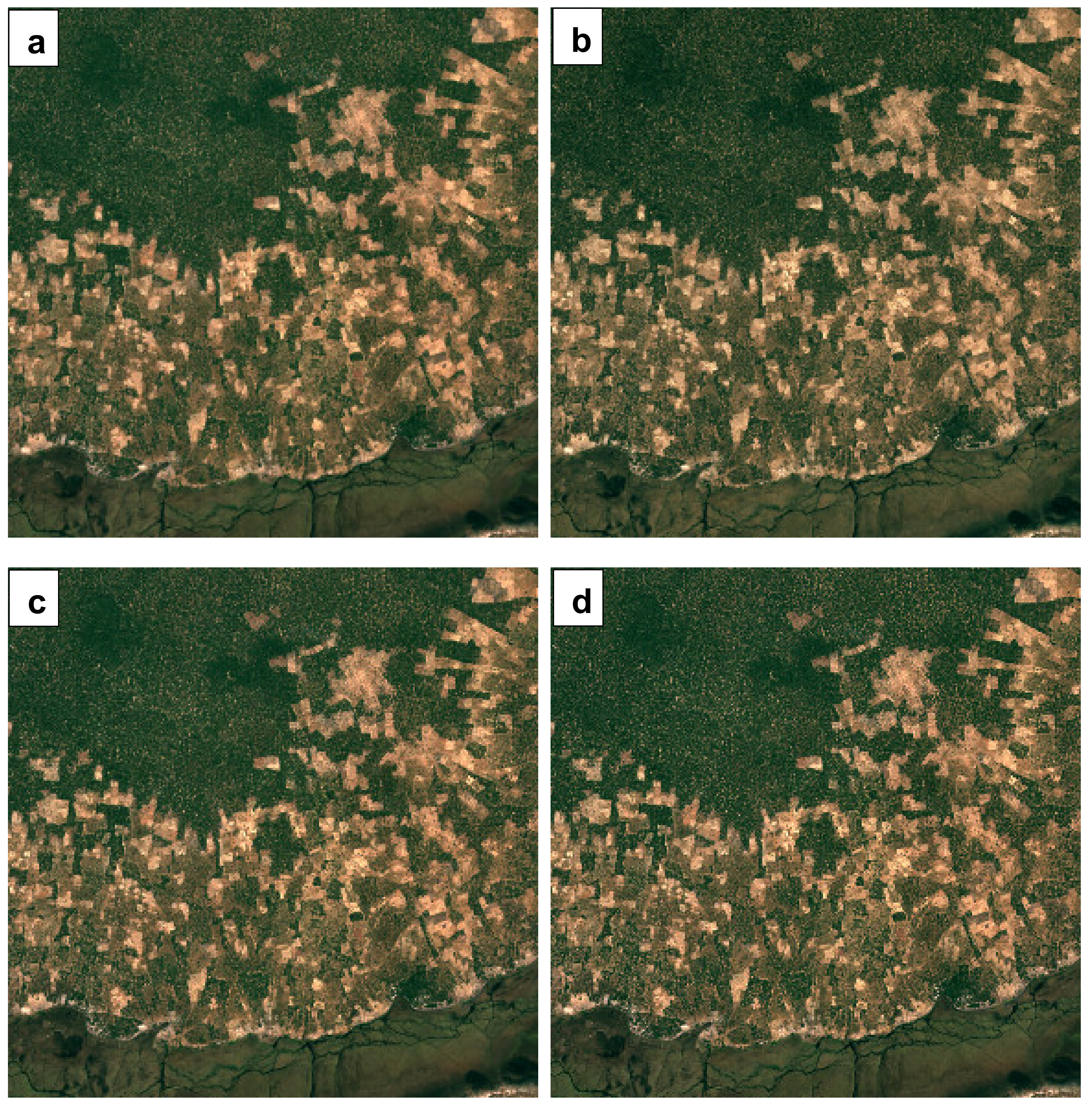



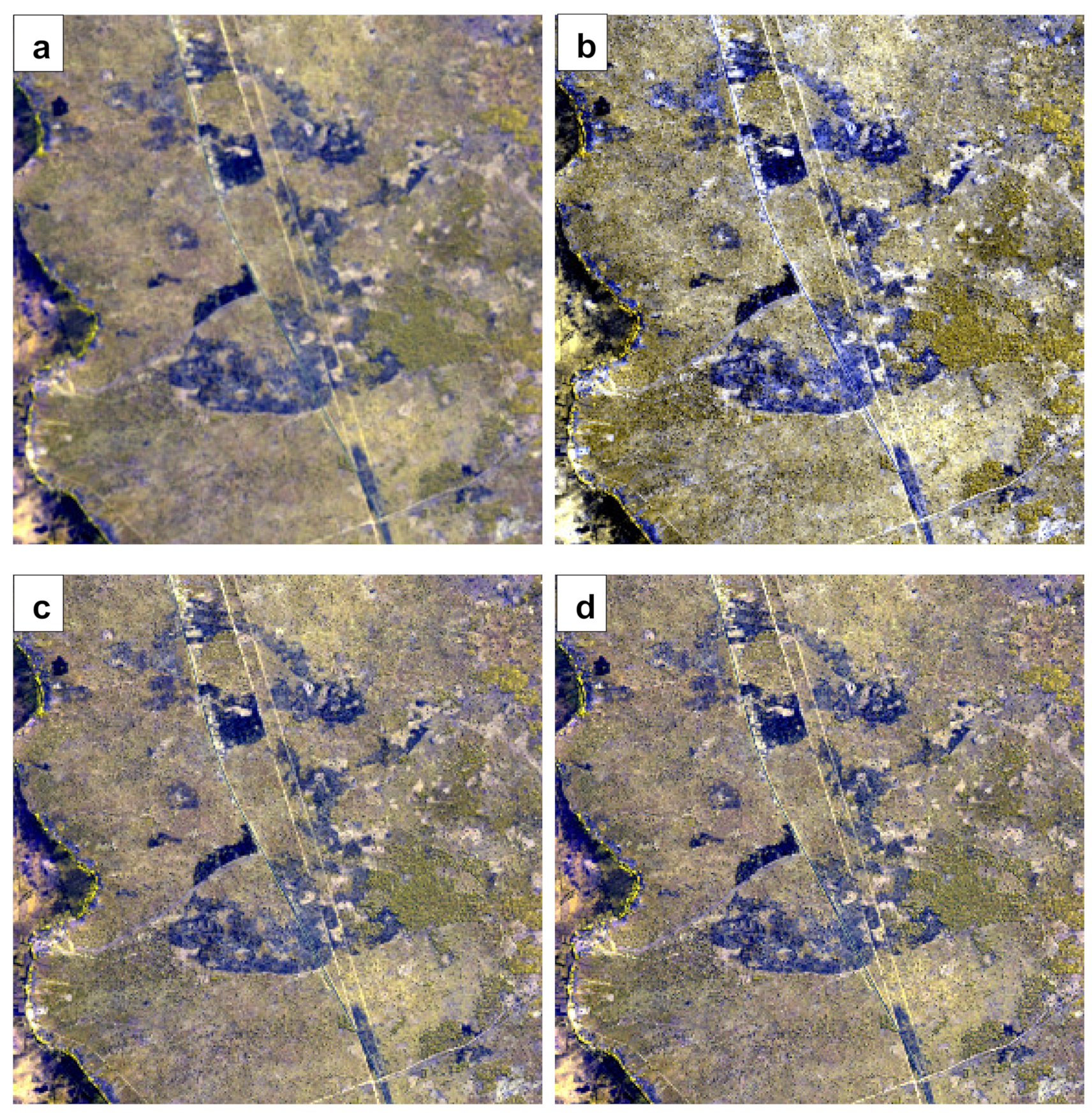
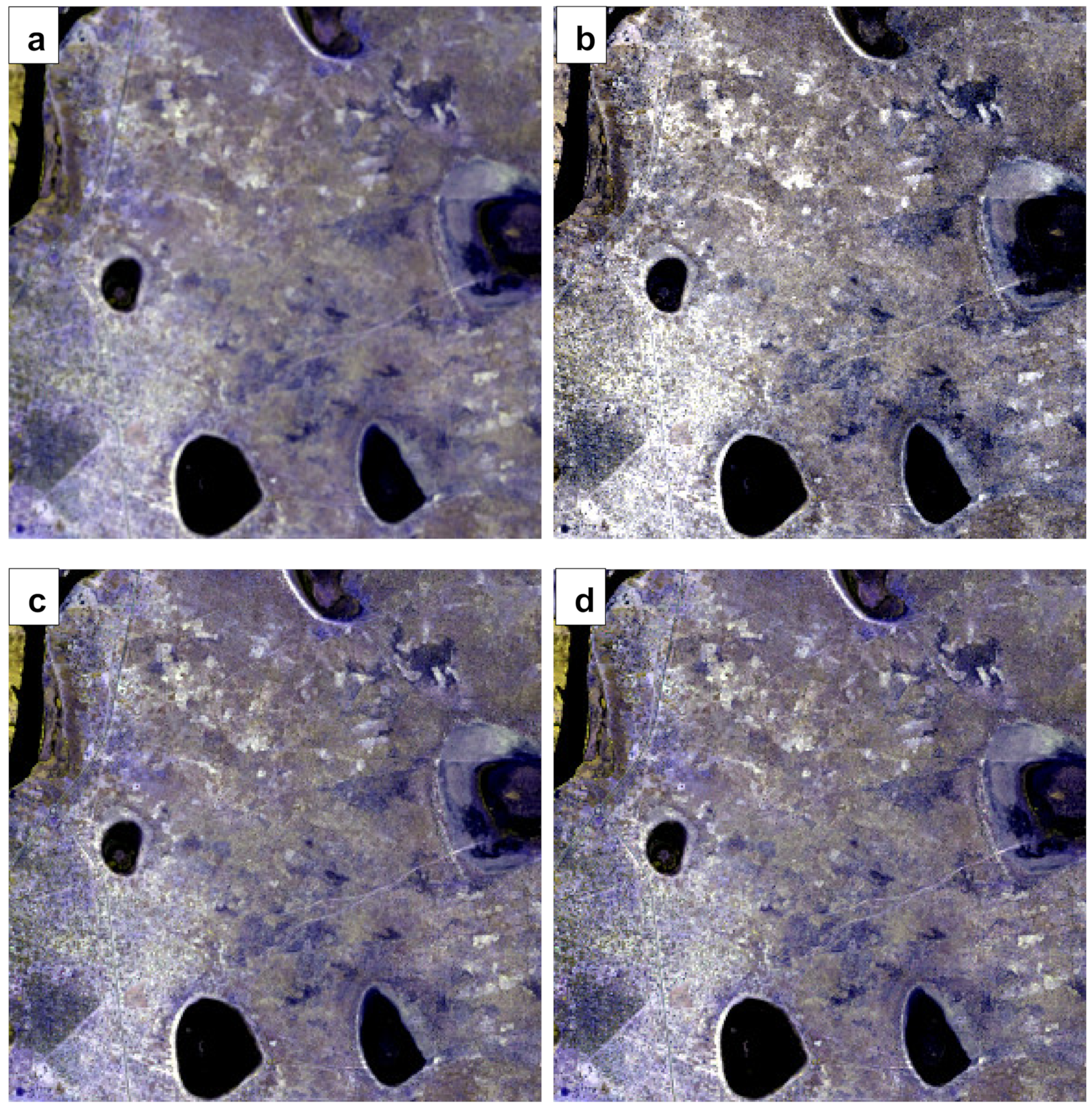
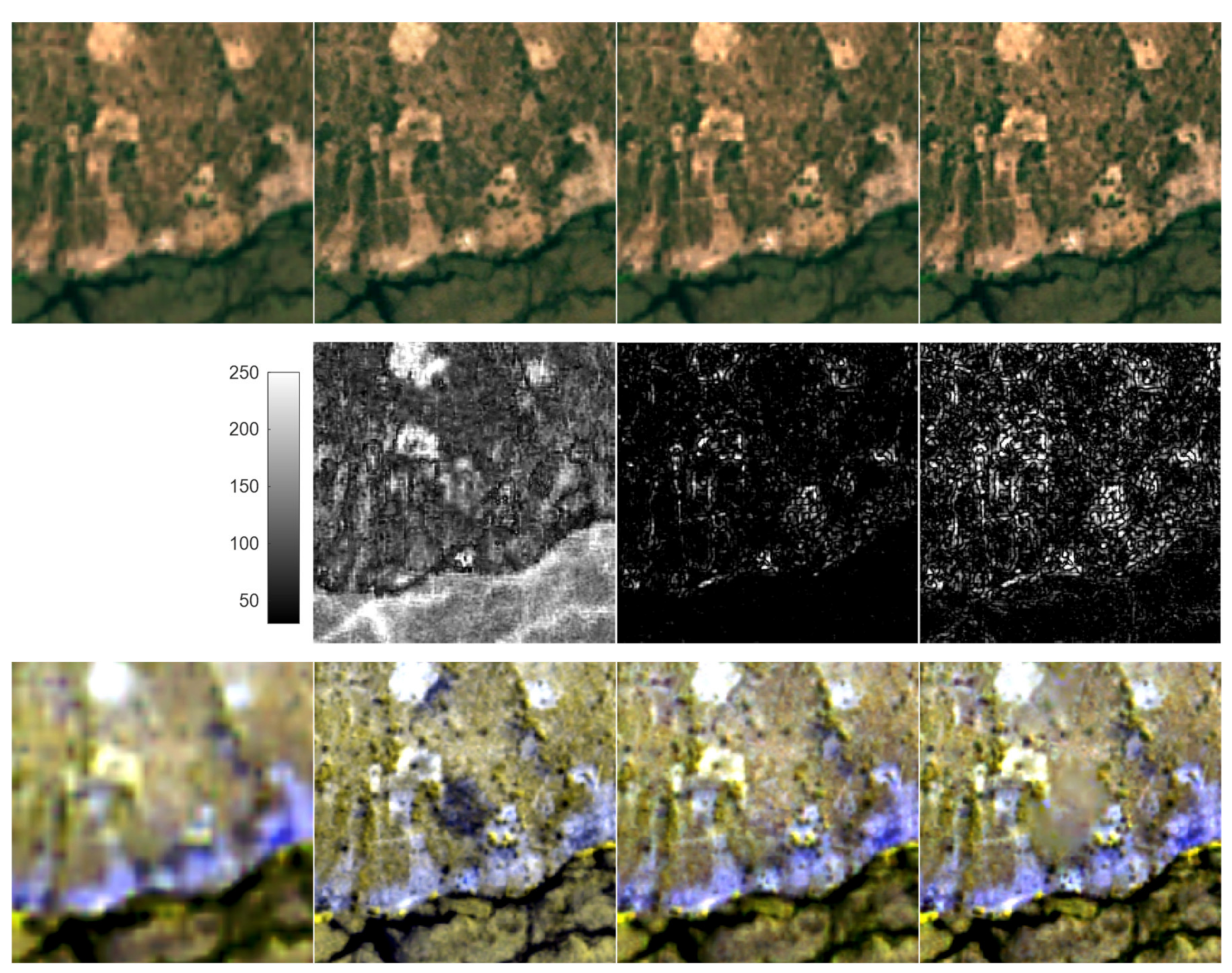


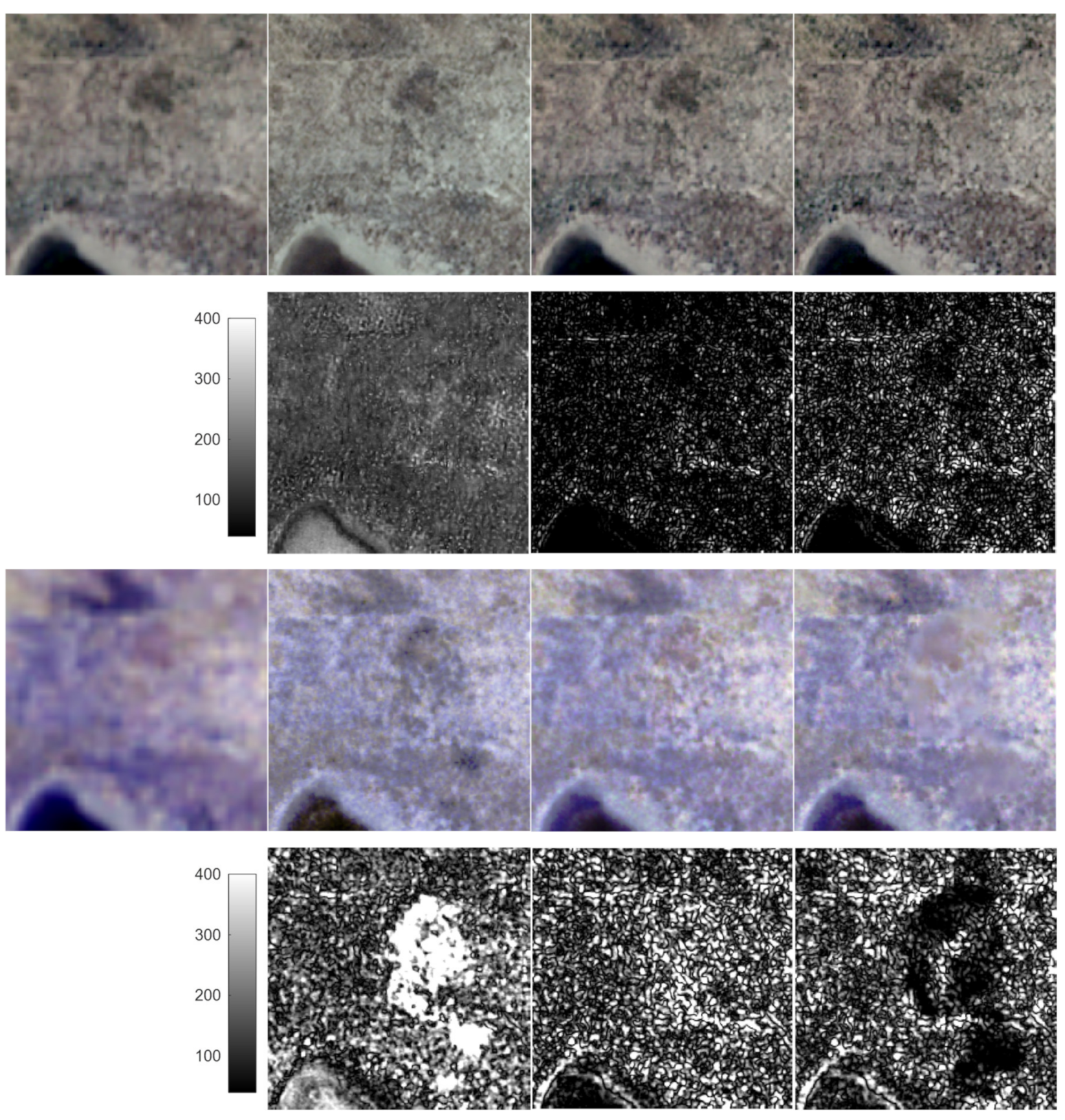
| Band | Sentinel-2 | Planetscope-0 | ||
|---|---|---|---|---|
| Band (Bandwidth) | Pixel Size | Band (Bandwidth) | Pixel Size | |
| Blue | 458–523 (65 nm) | 10 m | 455–515 (60 nm) | 3 m |
| Green | 543–578 (35 nm) | 10 m | 500–590 (90 nm) | 3 m |
| Red | 650–680 (30 nm) | 10 m | 590–670 (80 nm) | 3 m |
| Red-edge | 697–713 (16 nm) | 20 m | - | |
| Red-edge | 732–748 (16 nm) | 20 m | - | |
| Red-edge | 773–793 (20 nm) | 20 m | - | |
| NIR | 785–900 (115 nm) | 10 m | 780–860 (80 nm) | 3 m |
| NIR | 855–875 (20 nm) | 20 m | - | |
| SWIR | 1565–1655 (90 nm) | 20 m | - | |
| SWIR | 2100–2280 (180 nm) | 20 m | - | |
| Lon/Lat of Top Left Corner | Acquisition Date in 2018 | Acquisition Time (UTC) | |
|---|---|---|---|
| Study site 1 | 23°41′55″ E, 15°40′51″ S | S2B: 30 July Planet: 31 July | S2B: 08:15:59 Planet: 08:08:57 |
| Study site 2 | 23°12′59″ E, 15°27′20″ S | S2B: 30 July Planet: 31 July | S2B: 08:15:59 Planet: 08:12:08 |
| Study site 3 | 23°18′08″ E, 16°03′33″ S | S2B: 30 July Planet: 31 July | S2B: 08:15:59 Planet: 09:05:25 |
| Bilinear | HPM | M3 | HPM-M3 | |
|---|---|---|---|---|
| Study site 1 | 0.5736 | 0.9328 | 0.9650 | −0.0322 |
| Study site 2 | 0.5777 | 0.9628 | 0.9544 | 0.0084 |
| Study site 3 | 0.6319 | 0.9632 | 0.9599 | 0.0033 |
| 10 m Band | Site | Bilinear | HPM | M3 | HPM-M3 |
|---|---|---|---|---|---|
| Blue | Study site 1 | 0.5845 | 0.9112 | 0.9448 | −0.0336 |
| Study site 2 | 0.5807 | 0.9522 | 0.9309 | 0.0213 | |
| Study site 3 | 0.6231 | 0.9501 | 0.9426 | 0.0075 | |
| Green | Study site 1 | 0.5783 | 0.9355 | 0.9764 | −0.0409 |
| Study site 2 | 0.5769 | 0.9705 | 0.9673 | 0.0032 | |
| Study site 3 | 0.6264 | 0.9672 | 0.9653 | 0.0019 | |
| Red | Study site 1 | 0.5915 | 0.9207 | 0.9730 | −0.0523 |
| Study site 2 | 0.5828 | 0.9653 | 0.9655 | −0.0002 | |
| Study site 3 | 0.6241 | 0.9675 | 0.9615 | 0.0060 | |
| NIR (785–900 nm) | Study site 1 | 0.5080 | 0.9517 | 0.9601 | −0.0084 |
| Study site 2 | 0.5307 | 0.9578 | 0.9504 | 0.0074 | |
| Study site 3 | 0.6257 | 0.9616 | 0.9685 | −0.0069 |
| Bilinear | HPM | M3 | HPM-M3 | |
|---|---|---|---|---|
| Study site 1 | 0.2856 | 0.9182 | 0.9112 | 0.0070 |
| Study site 2 | 0.2889 | 0.8748 | 0.8625 | 0.0123 |
| Study site 3 | 0.3306 | 0.9020 | 0.9123 | −0.0103 |
| 20 m Band | Site | Bilinear | HPM | M3 | HPM-M3 |
|---|---|---|---|---|---|
| Red-edge (697–713 nm) | Study site 1 | 0.2702 | 0.9468 | 0.9441 | 0.0027 |
| Study site 2 | 0.2546 | 0.9279 | 0.9221 | 0.0058 | |
| Study site 3 | 0.2959 | 0.9412 | 0.9464 | −0.0052 | |
| Red-edge (732–748 nm) | Study site 1 | 0.2457 | 0.9200 | 0.9176 | 0.0024 |
| Study site 2 | 0.2408 | 0.8869 | 0.8727 | 0.0142 | |
| Study site 3 | 0.2989 | 0.9204 | 0.9228 | −0.0024 | |
| Red-edge (773–793 nm) | Study site 1 | 0.2441 | 0.9115 | 0.9054 | 0.0061 |
| Study site 2 | 0.2433 | 0.8674 | 0.8548 | 0.0126 | |
| Study site 3 | 0.3039 | 0.9179 | 0.9206 | −0.0027 | |
| NIR (855–875 nm) | Study site 1 | 0.2405 | 0.9170 | 0.9038 | 0.0132 |
| Study site 2 | 0.2442 | 0.9175 | 0.8931 | 0.0244 | |
| Study site 3 | 0.3043 | 0.9330 | 0.9458 | −0.0128 | |
| SWIR (1565–1655 nm) | Study site 1 | 0.2536 | 0.8643 | 0.8575 | 0.0068 |
| Study site 2 | 0.2361 | 0.7802 | 0.7657 | 0.0145 | |
| Study site 3 | 0.2715 | 0.8123 | 0.8385 | −0.0262 | |
| SWIR (2100–2280 nm) | Study site 1 | 0.2615 | 0.8636 | 0.8756 | −0.0120 |
| Study site 2 | 0.2712 | 0.8265 | 0.8099 | 0.0166 | |
| Study site 3 | 0.2809 | 0.8057 | 0.8237 | −0.0180 |
| Bilinear | HPM | M3 | HPM-M3 | |
|---|---|---|---|---|
| Study site 1 | 0.6148 | 0.9438 | 0.9707 | −0.0269 |
| Study site 2 | 0.5512 | 0.9528 | 0.9492 | 0.0036 |
| Study site 3 | 0.6340 | 0.9595 | 0.9589 | 0.0006 |
| 10 m band | Site | Bilinear | HPM | M3 | HPM-M3 |
|---|---|---|---|---|---|
| Blue | Study site 1 | 0.6270 | 0.9339 | 0.9606 | −0.0267 |
| Study site 2 | 0.5513 | 0.9574 | 0.9415 | 0.0159 | |
| Study site 3 | 0.6270 | 0.9629 | 0.9571 | 0.0058 | |
| Green | Study site 1 | 0.6230 | 0.9487 | 0.9851 | −0.0364 |
| Study site 2 | 0.5529 | 0.9716 | 0.9688 | 0.0028 | |
| Study site 3 | 0.6248 | 0.9751 | 0.9714 | 0.0037 | |
| Red | Study site 1 | 0.6191 | 0.9499 | 0.9808 | −0.0309 |
| Study site 2 | 0.5589 | 0.9651 | 0.9659 | −0.0008 | |
| Study site 3 | 0.6195 | 0.9712 | 0.9621 | 0.0091 | |
| NIR (785–900 nm) | Study site 1 | 0.5512 | 0.9377 | 0.9354 | 0.0023 |
| Study site 2 | 0.5092 | 0.9261 | 0.8719 | 0.0542 | |
| Study site 3 | 0.6217 | 0.9257 | 0.9141 | 0.0116 |
| Bilinear | HPM | M3 | HPM-M3 | |
|---|---|---|---|---|
| Study site 1 | 0.2714 | 0.9189 | 0.8770 | 0.0419 |
| Study site 2 | 0.2131 | 0.8036 | 0.8217 | −0.0181 |
| Study site 3 | 0.4330 | 0.8490 | 0.8601 | −0.0111 |
| 20 m band | Site | Bilinear | HPM | M3 | HPM-M3 |
|---|---|---|---|---|---|
| Red-edge (697–713 nm) | Study site 1 | 0.2171 | 0.9592 | 0.9315 | 0.0277 |
| Study site 2 | 0.1792 | 0.8746 | 0.8579 | 0.0167 | |
| Study site 3 | 0.3396 | 0.9213 | 0.9146 | 0.0067 | |
| Red-edge (732–748 nm) | Study site 1 | 0.2386 | 0.8915 | 0.8582 | 0.0333 |
| Study site 2 | 0.1578 | 0.7961 | 0.7216 | 0.0745 | |
| Study site 3 | 0.3454 | 0.8630 | 0.8504 | 0.0126 | |
| Red-edge (773–793 nm) | Study site 1 | 0.2481 | 0.8602 | 0.8325 | 0.0277 |
| Study site 2 | 0.1796 | 0.7644 | 0.6893 | 0.0751 | |
| Study site 3 | 0.3803 | 0.8379 | 0.8292 | 0.0087 | |
| NIR (855–875 nm) | Study site 1 | 0.2569 | 0.8620 | 0.8189 | 0.0431 |
| Study site 2 | 0.1883 | 0.8401 | 0.7469 | 0.0932 | |
| Study site 3 | 0.4097 | 0.8414 | 0.8273 | 0.0141 | |
| SWIR (1565–1655 nm) | Study site 1 | 0.2114 | 0.8740 | 0.7865 | 0.0875 |
| Study site 2 | 0.1516 | 0.7228 | 0.7467 | −0.0239 | |
| Study site 3 | 0.3810 | 0.7030 | 0.7546 | −0.0516 | |
| SWIR (2100–2280 nm) | Study site 1 | 0.2303 | 0.9119 | 0.8877 | 0.0242 |
| Study site 2 | 0.2069 | 0.8022 | 0.7687 | 0.0335 | |
| Study site 3 | 0.3261 | 0.7844 | 0.8322 | −0.0478 |
© 2020 by the authors. Licensee MDPI, Basel, Switzerland. This article is an open access article distributed under the terms and conditions of the Creative Commons Attribution (CC BY) license (http://creativecommons.org/licenses/by/4.0/).
Share and Cite
Li, Z.; Zhang, H.K.; Roy, D.P.; Yan, L.; Huang, H. Sharpening the Sentinel-2 10 and 20 m Bands to Planetscope-0 3 m Resolution. Remote Sens. 2020, 12, 2406. https://doi.org/10.3390/rs12152406
Li Z, Zhang HK, Roy DP, Yan L, Huang H. Sharpening the Sentinel-2 10 and 20 m Bands to Planetscope-0 3 m Resolution. Remote Sensing. 2020; 12(15):2406. https://doi.org/10.3390/rs12152406
Chicago/Turabian StyleLi, Zhongbin, Hankui K. Zhang, David P. Roy, Lin Yan, and Haiyan Huang. 2020. "Sharpening the Sentinel-2 10 and 20 m Bands to Planetscope-0 3 m Resolution" Remote Sensing 12, no. 15: 2406. https://doi.org/10.3390/rs12152406






